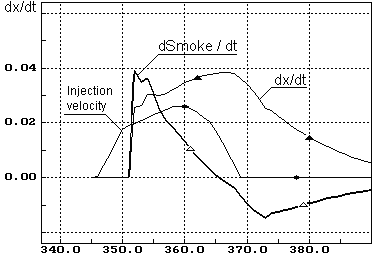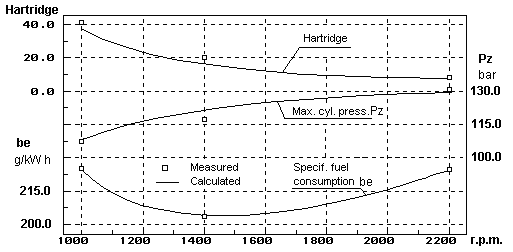Simulation of Soot formation in diesel
Method for simulation of soot formation and burning in
diesel cylinder was developed by Dr., Prof. Razleitsev /1/. Method takes into account
features of sprayed fuel burning. It is assumed, the soot is formed mainly by two ways:
- As a result of chain destructive transformation of molecules of fuel diffusing from the
surface of drops to the front of a flame.
- Owing to high-temperature thermal polymerization and dehydrogenization of a vapor-liquid
core of evaporating drops.
In parallel to this, the process of burning of soot particles and reduction of their
volumetric concentration owing to expansion occurs.
Detailed description of equations is presented in /1/,
therefore only end formulas are presented in this page.
Soot formation rate in a burning zone is:

where: V is a current volume of cylinder;
qc is a
cycle fuel mass;
dx/dt is a heat
release rate.
Soot formation rate due to high-temperature thermal
polymerization of drops nucleuses is proportionate to rate of disappearance of drops
because of full evaporation. In different processes one is calculated with different
equations.
In injection
period: 
where: t is a current time from
injection beginning,
t впр
is an injection duration,
n' is a factor of
distribution (for diesels injectors: n' = 2..4),
K is a constant of evaporation,
d32 is a mean Sauted
diameter of drops.
After injection termination:

where: t 2 is a current
time after injection termination;
xkвпр is a fraction of heat
released at the end of injection.
Rate of soot burning: 
where: p is a current cylinder pressure, MPa,
[C] = C / V is a current soot concentration
in cylinder.
Rate of soot concentration decrease because
of expansion:

Resulting rate of soot formation and
burning:

where:  is an
empiric factor, is an
empiric factor,
n is RPM,
nном is RPM at full
capacity,
A, m are calibrate coefficients.
Exhaust gas soot concentration related to normal
conditions:

where: p480 is a cylinder pressure at 60o
before BDC,
k is an exhaust gas adiabatic exponent
(1.33).
Hartridge smoke level is:

Alike equations are used to calculate Bosch
smoke number and Factor of Absolute Light Absorption: K, m-1.
Particulate Matter emission is calculated
by equation of Alkidas /2/ as a function of Bosch smoke number:

Results of simulation of soot release
rate in cylinder of truck diesel KamAZ 7405 are presented in fig. 1.

Fig. 1. Soot release rate in cylinder of truck diesel KamAZ 7405
(RPM=2200; BMEP=9.5 bars)
A comparison of calculated engine
parameters with measured ones at operating of engine in external torque curve is presented
in fig. 2. Injection profiles were specified for each operating point of performance.

Fig. 2. External performance of truck diesel KamAZ 7405
Measured data were presented by KamAZ R&D
Center.
Bibliography

To page "Calculation
models"










|



